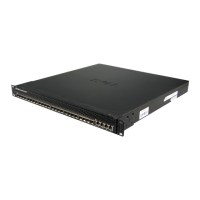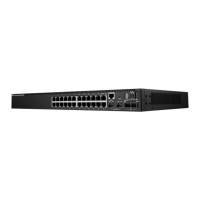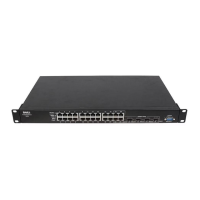Using the CLI 115
Command Scripting
The CLI can be used as a programmable management interface. To facilitate this function, any
characters entered after the <!> character are treated as a comment and ignored by the CLI.
Also, the CLI allows the user to disable session timeouts.
CLI Command Notation Conventions
When entering commands there are certain command-entry notations which apply to all
commands. The following table describes these conventions as they are used in syntax
definitions.
Interface Naming Conventions
The conventions for naming interfaces in CLI commands are as follows:
• Unit#/Interface ID — each interface is identified by the
Unit#
followed by a </> symbol
and then the
Interface ID
. For example,
2/g10
identifies the gigabit port 10 within the second
unit.
• Unit# — the unit number is used only in a stacking solution where a number of switches are
stacked to form a virtual switch. In this case, the
Unit #
identifies the physical switch
identifier within the stack.
• Interface ID — is formed by the interface type followed by the interface number. For
example,
2/g10
identifies the gigabit port 10 on the second unit;
1/g1
identifies the fast
Ethernet port 1 on the first unit within the stack.
• Interface Types — the following interface types are defined.
g
stands for gigabit Ethernet port
(for example,
g2
is the gigabit port 2).
xg
stands for 10 Gigabit Ethernet port (for example,
xg2 is the 10 gigabit Ethernet port 2).
Convention Description
[ ] In a command line, square brackets indicate an optional entry.
{ } In a command line inclusive brackets indicate a selection of compulsory parameters
separated by the | character. One option must be selected. For example: flowcontrol
{auto|on|off} means that for the flowcontrol command either auto, on or off must
be selected.
Italic
Indicates a variable.
<Enter> Any individual key on the keyboard.
<Ctrl>+<F4> Any combination of keys pressed simultaneously on the keyboard.
Screen Display Indicates system messages and prompts appearing on the console.
all Indicates a literal parameter, entered into the command as it is.

